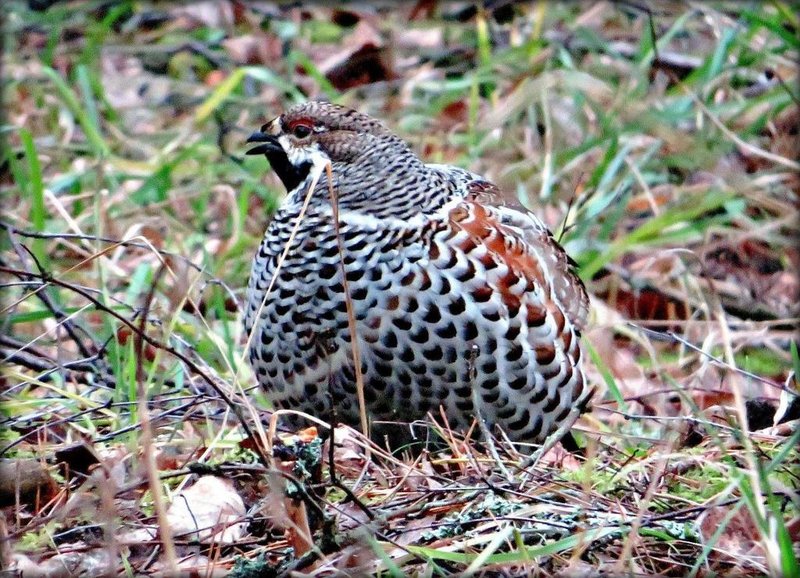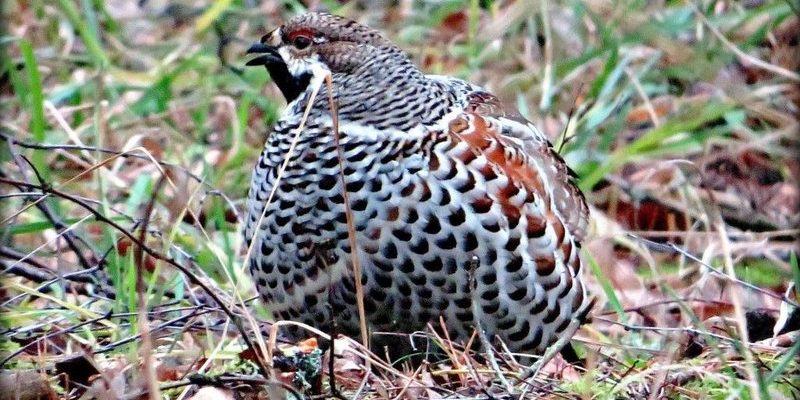
The Hazel Grouse is a fascinating bird that often goes unnoticed in its natural habitat. Imagine wandering through a quiet forest, the leaves crunching underfoot, and suddenly spotting a bird that seems perfectly camouflaged against the branches. This is the essence of the Hazel Grouse. With its mottled feathers and shy demeanor, this bird is not just a beautiful sight but also a remarkable example of nature’s clever adaptations.
As part of the grouse family, the Hazel Grouse has unique traits and behaviors that make it a subject of interest for bird enthusiasts and casual observers alike. From its habitat preferences to its diet, each aspect of the Hazel Grouse tells a story about survival and adaptation in the wild. So, if you’re curious about this elusive creature, let’s explore its world together!
Physical Characteristics
The Hazel Grouse is a medium-sized bird, typically measuring about 30-35 centimeters in length. One of the most striking features of this bird is its plumage, which offers excellent camouflage in its forested habitat. Its feathers are predominantly brown and gray, often with a mix of black and white patterns that help it blend seamlessly into the underbrush. This is particularly beneficial when predators are lurking nearby.
In terms of size, the male and female Hazel Grouse are quite similar, though males tend to be slightly larger. They have a rounded body, short tail, and strong legs designed for quick movements through dense vegetation. The breast and belly feathers have a paler hue, contrasting beautifully with the darker back, which is perfect for hiding among the leaves and branches.
One interesting aspect of their physical makeup is their feet. The Hazel Grouse has feathered legs with small scales that help them navigate snowy terrains. This adaptation ensures they can move around with relative ease even in harsh winter conditions, making them well-suited for their habitat.
Habitat and Distribution
Hazel Grouse are found primarily in the dense, mixed forests of Europe and parts of Asia. They prefer areas with a rich understory, where they can find plenty of cover and food sources. Think of these forests as their private dining room and home, where the combination of trees, shrubs, and open spaces creates an ideal environment.
You might be wondering why this bird is drawn to such specific habitats. The answer lies in their diet, which consists mainly of leaves, buds, and berries. The variety of vegetation in these forests provides everything they need to thrive. However, they are not just picky eaters; they also adapt their diet based on the season, something that helps them survive in changing conditions.
In terms of geographical range, the Hazel Grouse is quite widespread. They inhabit forests from the northern parts of Europe all the way to Siberia. In fact, as you travel through different regions, you may notice slight variations in their appearance and behaviors, showcasing the adaptability of this charming bird.
Diet and Feeding Habits
The diet of the Hazel Grouse is diverse and largely influenced by the seasons. During the spring and summer months, they feast on tender leaves, buds, and a range of berries. This time of year is critical for them, as the abundance of food supports breeding and raising their young. It’s like a summer buffet, where every bite is vital for building strength and vitality.
As autumn approaches and winter sets in, their diet shifts. They may turn to fir and spruce needles, which provide essential nutrients even when other food sources are scarce. This ability to adapt their diet is crucial for their survival in varying weather conditions. You can imagine them foraging through the snowy ground, searching for whatever nourishment they can find.
Interestingly, Hazel Grouse also display a unique behavior when feeding. They often feed in the early morning or late afternoon, which is when they feel safest from predators. This strategy of being active during these times emphasizes their instinctual drive to avoid danger while satisfying their hunger.
Behavior and Social Structure
When it comes to behavior, the Hazel Grouse is generally solitary or found in small family groups. Males are known to be quite territorial, especially during the breeding season. They often engage in elaborate displays, including puffing out their feathers and making distinctive calls to attract females. You can picture a male performing a little dance, trying to impress potential mates—it’s a delightful sight!
During the winter, however, you might find them foraging together in small groups. This change in social dynamics helps them find food more efficiently and offers some safety in numbers. Throughout the year, their behaviors are largely influenced by the availability of food and the presence of mates.
One fascinating aspect of their social structure is their mating behavior. The courtship rituals of the Hazel Grouse can be quite elaborate; males will often create “display areas” where they perform their dances to woo females. This aspect of their behavior not only highlights their vibrant personalities but also their instincts to ensure the continuation of their species.
Reproduction and Lifecycles
Reproduction among Hazel Grouse typically occurs in late spring. The females build nests on the ground, usually in dense vegetation, which offers protection from predators. A typical clutch can consist of 5 to 10 eggs, which the female incubates for about 24 days. It’s fascinating to think about how this bird carefully selects its nesting site to maximize the chances of survival for its chicks.
Once the chicks hatch, they are precocial, meaning they are relatively mature and mobile. They can leave the nest within hours and start foraging for food with their mother. This quick development is crucial since the young birds need to learn how to fend for themselves while still under the watchful eye of their parent.
As they grow, the young Hazel Grouse learn important survival skills, including where to find food and how to evade predators. The bond between the mother and her chicks is strong during this formative period, showcasing how vital nurturing is for the growth of these birds. By summer’s end, the young are usually independent but may still stay close to their mother for a while longer.
Conservation Status
The Hazel Grouse is currently listed as a species of “Least Concern” by conservation organizations, but this doesn’t mean they are free from threats. Habitat loss due to urbanization and deforestation poses risks to their populations. The delicate balance of their forest ecosystems is something we need to pay attention to. Just like a house of cards, when one piece is removed, the whole structure can come tumbling down.
Conservation efforts are essential to ensuring the survival of this species. Initiatives aimed at preserving forest habitats and promoting biodiversity play a vital role in protecting not only Hazel Grouse but countless other species that rely on these ecosystems. Supporting local conservation groups can help make a difference—every little bit counts!
Public awareness is equally important. Understanding the challenges faced by the Hazel Grouse can inspire people to get involved, whether through advocacy, education, or even simple everyday choices that promote environmental health. After all, we all share this planet, and protecting it leads to a better future for all its inhabitants.
Interesting Facts
| Common Name: | Hazel Grouse |
| Scientific Name: | Bonasa bonasia |
| Size: | 30-35 cm |
| Weight: | 400-600 g |
| Habitat: | Mixed forests with dense understory |
| Diet: | Leaves, buds, berries, fir and spruce needles |
| Breeding Season: | Late spring |
| Chick Development: | Precocial (can leave the nest hours after hatching) |
Human Interaction
Human interaction with the Hazel Grouse is a complex topic. On one hand, they are a beloved species among birdwatchers and nature enthusiasts. Many people take pleasure in spotting them in their natural habitats, gaining joy from simply observing their unique behaviors and beautiful plumage. Birdwatching offers a way to connect with nature, promoting appreciation for wildlife and its protection.
On the other hand, activities such as logging and urban development can disrupt their habitats. When these birds lose their homes, it impacts not just their population but the overall health of the ecosystem they are part of. It’s a reminder that our actions have consequences, and by making conscious choices, we can help protect these wonderful creatures.
Interestingly, some regions have implemented hunting regulations to manage grouse populations sustainably, allowing for controlled hunting that doesn’t significantly harm the overall numbers. This balance between enjoying nature and conserving it is delicate, highlighting the need for educated choices regarding wildlife interactions.
FAQ
What is the best time to see Hazel Grouse in the wild?
The best time to observe Hazel Grouse is during the early morning or late afternoon when they are most active. These periods allow for easier spotting as the birds venture out to forage for food.
Are Hazel Grouse good fliers?
While Hazel Grouse can fly, they prefer to stay close to the ground and often rely on their excellent camouflage to avoid predators. Their flight is typically short and low, making them more adept at navigating through dense forest cover.
How do Hazel Grouse communicate?
These birds communicate through a series of coos and soft clucks, especially during the breeding season. Males are particularly vocal when trying to attract females, using calls that can carry through the forest.
Can Hazel Grouse be kept as pets?
Keeping Hazel Grouse as pets is generally not recommended. They are wild birds that require specific habitats and diets to thrive. Additionally, it’s important to respect wildlife and allow these beautiful creatures to live in their natural environments.
What predators threaten Hazel Grouse?
Hazel Grouse face threats from various predators, including foxes, hawks, and owls. Their primary defense is their ability to blend into their surroundings, avoiding detection by these hunters.
Do Hazel Grouse migrate?
Hazel Grouse are not typical migratory birds. Instead, they remain in their home ranges throughout the year, adapting to seasonal changes in food availability during the winter and summer months.
How significant is habitat loss for the Hazel Grouse population?
Habitat loss poses a considerable threat to Hazel Grouse populations. As forests are cleared for agriculture and urban development, these birds lose their natural homes, which directly impacts their ability to thrive.
What conservation efforts are in place for the Hazel Grouse?
Conservation efforts for Hazel Grouse include habitat preservation initiatives, promoting sustainable forest management, and raising awareness about their ecological importance. These actions help ensure that their populations remain stable and healthy.

